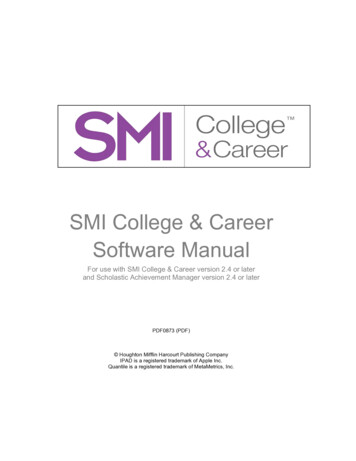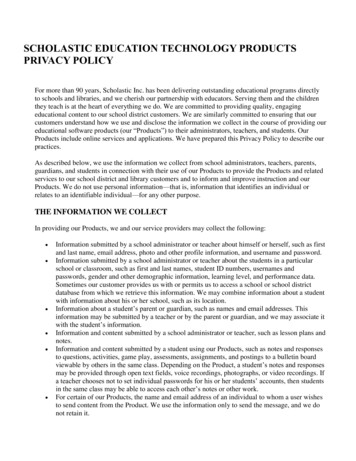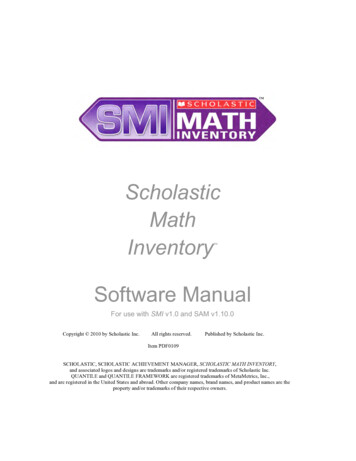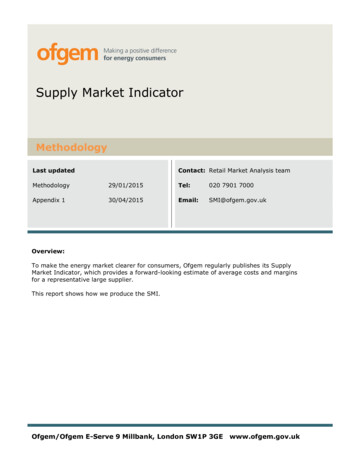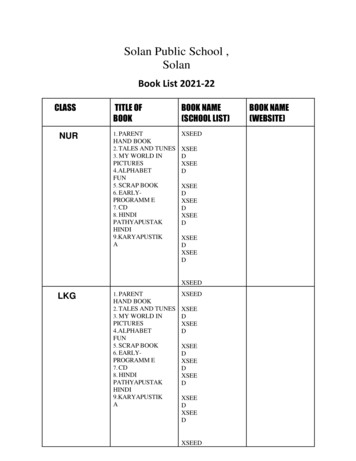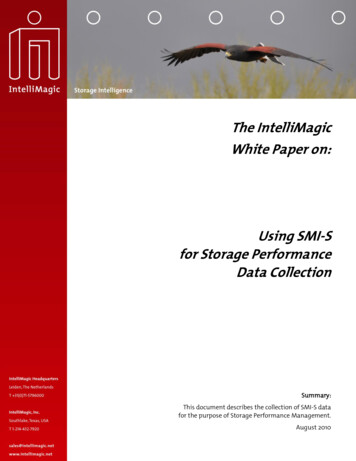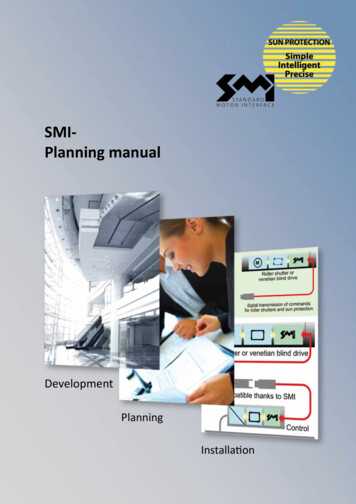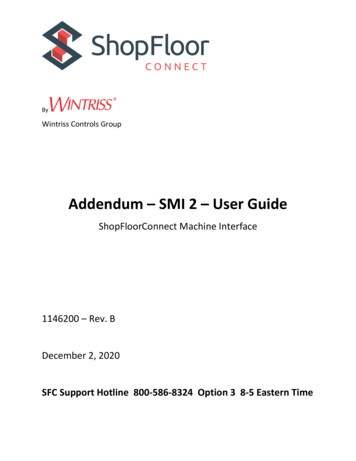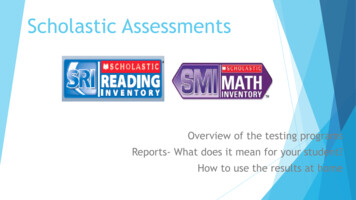
Transcription
Scholastic AssessmentsOverview of the testing programsReports- What does it mean for your student?How to use the results at home
SRI- Scholastic Reading Inventory*Online computer adaptive assessment given to K-12 students.SRI - Two Different Types of TestsFoundational Test (phonics, letter name, sound)This is given to students in K-2. The Foundational Test results are reported asFluency Scores.Comprehension Test (comprehension, reading)This is given to grades 3-12 and those that score greater than 49 on theFoundation Test. The Comprehension Test scores are reported in Lexiles.*Both assessment types are adaptive – This means that the questions change asstudents answer correctly or incorrectly to adjust to the student’s level.
SRI – Foundation TestAccuracy and fluency are twoessential components of being ableto read. The assessment measuresboth by assessing the following; phonological awareness letter- name knowledge letter sound sight word recognition decoding of nonwordsGrade Level Fluency Ranges areabove. SCOH students begin with thefoundation assessment in K-2 to ensurethat they have the accuracy andfluency to read. A student with afluency measure of 49 or above wouldbe ready for the SRI Comprehensionassessment.
Foundational Reading Assessment Scoring GuideFluency and accuracy is broken downfurther for the Foundational ReadingAssessment Scoring Guide to the left.Based upon the score, teachers can pinpointwhat areas each student is excelling in andthose that need additional practice.Knowing this assessment information alongwith a child’s performance in the classroom,a student’s plan becomes detailed andspecific to the individual.
SRI- Comprehension TestThe SRI-Comprehension Test and the SMI assessmentmeasures are based upon national levels. The charts onthe following pages are end of year performance bands.These levels are broken into four performance levels.Advanced: Superior performance on grade level skills&concepts.Proficient: Competent performance on grade level skills& concepts.Basic: Minimal competent performance on grade levelskills & concepts.Below Basic: Doesn’t exhibit minimal competency ongrade level skills & concepts.
SRI Comprehension Test ReportingLexiles are a measure of how difficult a text is OR astudent’s reading ability levelAs students complete the SRI tests, growth towardsproficient and advanced are ideal.For students that begin in a lower band, they areexpected to grow more than a student that begins at anadvanced band. This is because a student that beginslower has more room to grow.Ideally, students at the elementary level should begaining 150 lexiles and middle/high school students willgain 50-70 lexiles.Keep in mind, each child is unique and so is his/herperformance. With this in mind, students should becontinually progressing within each band and movingahead from one performance band to the next.
Sample Books andLexile Levels1110L: A Separate Peace1000L: Mythbusters Science Fair Books990L: Sea biscuit870L: The 7 Habits of Highly Effective Teens840L: The Odyssey760L: Hoot!560L: Sarah, Plain and Tall520L: John Henry: An American Legend460L: True Life Treasure Hunts380L: Junie B. Jones is a Flower Girl350L: A Snowy Day260L: The Cat in the Hat
SMI- Scholastic Math Inventory*Online computer adaptive assessment given to K-8 students.SMI is used to determine a student’s readiness for math instruction.Scoring is reported in Quantiles. Knowing what a student’s quantile provides amethod of knowing what a student is ready to learn in math.K-2 AssessmentScreens for early numeracy and basic fact fluency3-8 AssessmentScreens for fact fluency (add, sub, mult, division)Readiness for math instruction through Algebra II.
SMI - ReportingSMI assessment measures are also based uponnational levels. The charts on the following pagesare end of year performance bands.These levels are broken into four performancelevels.Advanced: Superior performance on grade levelskills &concepts.Proficient: Competent performance on grade levelskills & concepts.Basic: Minimal competent performance on gradelevel skills & concepts.Below Basic: Doesn’t exhibit minimal competencyon grade level skills & concepts.
SMI PerformanceScores are reported in Quantiles. Below areexamples of questions and quantile levels.24Q:Count by 1s, 2s, 5s, 10s to100. Beginning at 2, 5, 10Kindergarten1022Q:Multiply & Dividedecimals usingmodels & picturesto explain theprocess & recordthe results.5th grade607Q:Writemultiplication& divisionsentences torepresent anumber or wordproblem; solve.4th grade
SMI Ideal GrowthAll students are unique and will grow atdifferent rates.As a guideline, Scholastic has provided thechart to the right.Just like SRI, students that are in a lowerperformance band have more room to growover the year.If a student began the year in 3rd gradescoring in a below basic range, he/she wouldhave the opportunity to grow 260 quantilesor more over the course of a year.Regardless of each child’s starting point,they should be growing through out the year.
College and Career Readiness ReportsThese reports are provided with reportscards. What do they mean?The goal for each child is continual progresstowards College & Career Readiness. SCOH’sgoal is to have students ready for collegeand/or a career upon graduation. Reachingfor CCR goals allows students to haveadditional choices during high school and upongraduation.CCR Goals for GraduationLexile Goal1300 by 12th gradeQuantile Goal1030 (Algebra Readiness)1400 by 12th grade (College/Career)
How are the scores used at school?1st: Focus is on critical foundational skillsLetter and number identification, phonics, fluency, comprehension and attending toprecision.2nd: Instructional supports.SRI and SMI provide another aspect to your student’s learning. The assessments provide amore in-depth focus of what each student is ready to learn and in which areas to supporthis/her learning.3rd: Whole group and small group interventionBased on the results, teachers will instruct students according to their need. Studentperformance in class and on the assessment may indicate that the student is ready to bechallenged in one area and need another review of information in a different area.SRI and SMI are always used in combination with classroom performanceto provide a full picture of each student’s skill level and achievement.
How To Use The Results At HomeRead! Read! Read!SCOH encourages families to readnightly and work to achieve fluency andcomprehension of all types of text.As you read together, stop and talkabout the characters, theme or topicand any words that are unknown.Technology isuseful.However, kidsstill need toknow their mathfacts!Math Practice is Essentialfor All Students!All K-12 students should practice facts that are ageappropriate. Students must master addition,subtraction, multiplication, and division facts. Theymust also remember these facts even in high school!!Practicing these skills are essential for all ages!
Resources for Home Practice math facts each night Be Active and Learn at the Same TimeIt’s always good to have students active and eatingnutritional foods!-Run, Skip, Jump Rope (Count and/or practice facts)-Using household items – develop a marble run*use measurement and communication to plan itApply math in every day life Local library Have children participate in afterschool clubs and study tables. Lexile Framework for Reading Map:http://cdn.lexile.com/m/cms page media/135/Lexile%20Map 8.5x11 FINALUpdated May 2013%20%284%29.pdf Contains ELA and Math Practice Mathinenglish.com Ixl.comMath Activities by Quantiles: Quantiles.com –http://mah.quantiles.com/ Scholastic Math Database- http://www.scholastic.com/mathdatabase/
Questions? Thank you for attending the presentation
SMI- Scholastic Math Inventory *Online computer adaptive assessment given to K-8 students. _ SMI is used to determine a student's readiness for math instruction. Scoring is reported in Quantiles. Knowing what a student's quantile provides a method of knowing what a student is ready to learn in math. K-2 Assessment
